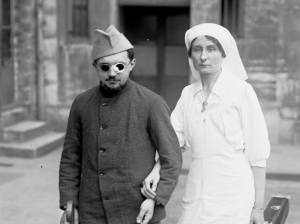
 Rehabilitation of blind soldiers [1916] : [press photograph] / [Agence Rol], Gallica.The Great War marked a second turning point in the history of social policies towards the blind.
Rehabilitation of blind soldiers [1916] : [press photograph] / [Agence Rol], Gallica.The Great War marked a second turning point in the history of social policies towards the blind.
18th and 19th century medical dictionaries termed “blind” a person bereft of eyesight as a birth defect, through illness, trauma or old age. Throughout the ages, the image of the blind is bound in representations affecting the visually-impaireds’ social integration possibilities. Ever since Antiquity, blindness has been perceived as a particular type of impairment. In mythology the blind kept up a close relation with the divine; their condition, frequently caused by a violation of natural or divine order (Œdipus,Tyresias), could only be remedied by divine intervention. Sight-loss would then be attended by, say, a compensatory prophetic gift or musical talent. Such conceptions betoken both the worth given the sense of sight, the loss of which is a tragedy, and the heightening of the other senses observed among the blind. Blindness is historically a condition associated with poverty, as their inability to work often forced blind people on other’s mercy. Blind members of the privileged classes represent a separate category afforded access to education, thanks to private tuition, and to some forms of leisure such as reading (aloud), music and walks.
Until the 18th century, the response of the sighted to the plight of the blind was assistance as stipulated by the principles of Christian charity. The Hospice des Quinze-vingt, the first institution created in France in support of the blind, epitomizes this attitude. Created in the 13th century by Louis IX and managed by the Great Almoner of France, this institution housed 300 blind boarders and their family. The home guaranteed their protection and subsistence but, banning them from work, relegated them to a state of inactivity and exclusion.
In the 18th century, the question of the educability of the blind got a first airing. Such philosophers as Diderot and Condillac asserted that lacking a sense need not imply intellectual impairment; thus, a blind person was apt to receive an education. The first to experiment with the group teaching of blind children was Valentin Haüy who founded in 1786 in Paris the Institution des Enfants aveugles. Nationalised under the Revolution, this establishment (now known as the Institut National des Jeunes Aveugles or INJA) connotes the end of the Church monopoly on blind relief initiatives. Educational institutions for the blind proliferated in the 19th century, which also oversaw the introduction of the Braille method, a writing system that encoded letters, mathematical symbols and musical notation. Structured into primary and secondary education, the schools for the blind taught such subjects as history geography, maths, music, crafts, equipping their students with the intellectual and practical education that would prepare them for the jobs traditionally considered within their reach (piano tuner, chair caner, cane weaver, cooper, cobbler, masseur). These institutions were aiming for the blind’s social inclusion through labour. In the event, the chances of finding a job that would ensure their economic independence were scarce even for a well-educated blind person, who often had to be supported by their family or depend on benevolent societies or job agencies.
The Great War marks a second turning point in the history of the blind. For the vast numbers of veterans who returned blind from the battlefields (3000 in France alone), the State organised a broad programme of professional re-training and financial support with a view to ease their social inclusion. Although this policy’s results were limited, it nevertheless initiated a pugnacious mutualism. Of all the war veteran associations, the war blind societies were the more effective in their socio-political action, thereby opposing to their traditional helpless image the figure of a combative, community-minded blind person. This militant period yielded social laws alert to the blind’s peculiar needs, but the allowances made rarely went all the way to ensure the possibility of true social integration. At the beginning of the 21st century, the blind’s access to education and labour remains restricted. The barriers to accessing a normal social life confirm the ongoing presence of discrimination.
Follow the reading on the dictionnary : Neurodiversity
References :
Gabriel Farrell, The Story of Blindness, Cambridge et Harvard University Press, 1956.
Zina Weygand, Vivre sans voir. Les aveugles dans la société française, du Moyen Age au siècle de Louis Braille, Créaphis Editions, 2003.
To quote this paper : Corinne Doria, "The Blind" in Hervé Guillemain (dir.), DicoPolHiS, Le Mans Université, 2021.